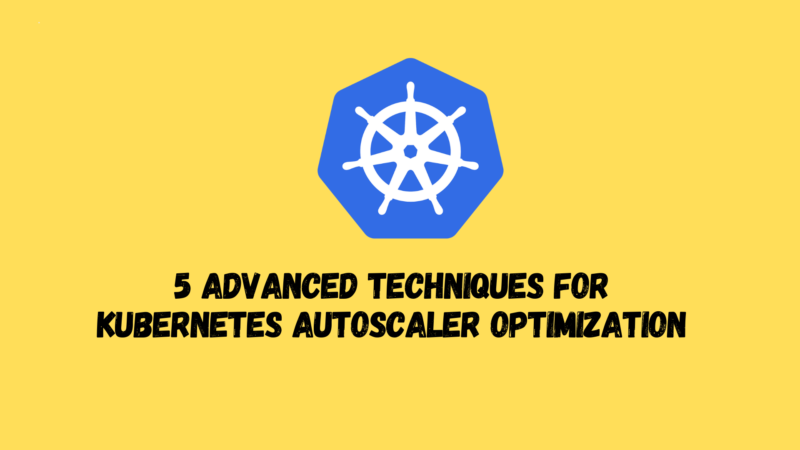Table of Contents Show
In the rapidly evolving landscape of Kubernetes, mastering autoscaling is essential for optimizing performance while controlling costs. For cloud engineering executives and technical leaders, fine-tuning autoscaler configurations presents a powerful opportunity to cut Kubernetes expenses by efficiently managing resource allocation.
This blog post explores five advanced strategies to optimize Kubernetes autoscalers, offering detailed code examples and links to essential Kubernetes documentation and GitHub repositories.
Implementing Custom Metrics for Horizontal Pod Autoscaler (HPA)
Kubernetes’ Horizontal Pod Autoscaler (HPA) automatically adjusts the number of pods in a deployment based on observed CPU utilization or custom metrics. Leveraging custom metrics beyond CPU and memory, such as request latency or queue length, can provide a more nuanced control over scaling.
How to Implement:
To use custom metrics with HPA, you need to deploy the Kubernetes Metrics Server and configure your HPA to use custom metrics provided by external sources like Prometheus.
apiVersion: autoscaling/v2beta2
kind: HorizontalPodAutoscaler
metadata:
name: custom-metric-hpa
spec:
scaleTargetRef:
apiVersion: apps/v1
kind: Deployment
name: your-deployment
minReplicas: 1
maxReplicas: 10
metrics:
- type: Pods
pods:
metric:
name: your_custom_metric
target:
type: AverageValue
averageValue: 500m
Relevant Links:
- Kubernetes HPA Documentation: https://kubernetes.io/docs/tasks/run-application/horizontal-pod-autoscale/
- Kubernetes Metrics Server: https://github.com/kubernetes-sigs/metrics-server
Vertical Pod Autoscaler (VPA) Fine-Tuning
While HPA scales the number of pods horizontally, the Vertical Pod Autoscaler (VPA) adjusts the CPU and memory resources allocated to the pods in a deployment. Fine-tuning VPA can significantly reduce resource wastage.
How to Implement:
To optimize VPA, consider setting both minAllowed and maxAllowed for resources, and use VPA in “Off” or “Initial” mode for production workloads to avoid unexpected pod restarts.
apiVersion: autoscaling.k8s.io/v1
kind: VerticalPodAutoscaler
metadata:
name: your-vpa
spec:
targetRef:
apiVersion: "apps/v1"
kind: Deployment
name: your-deployment
updatePolicy:
updateMode: "Off"
resourcePolicy:
containerPolicies:
- containerName: your-container
minAllowed:
cpu: "250m"
memory: "500Mi"
maxAllowed:
cpu: "1"
memory: "1Gi"
Relevant Links:
- Kubernetes VPA Documentation: https://github.com/kubernetes/autoscaler/tree/master/vertical-pod-autoscaler
Cluster Autoscaler Optimization
The Cluster Autoscaler automatically adjusts the size of a Kubernetes cluster so that all pods have a place to run and there are no unneeded nodes. Optimizing the Cluster Autoscaler involves configuring scale-down behaviors and pod disruption budgets to minimize unnecessary scaling actions that could lead to higher costs.
How to Implement:
Modify the cluster autoscaler’s settings to prevent it from scaling down too quickly after scaling up, and use Pod Disruption Budgets to ensure high-priority applications remain available.
kind: Deployment
metadata:
name: your-application
spec:
replicas: 3
template:
metadata:
labels:
app: your-application
spec:
containers:
- name: your-container
image: your-image
resources:
requests:
cpu: "100m"
memory: "100Mi"
Relevant Links:
- Cluster Autoscaler GitHub: https://github.com/kubernetes/autoscaler/tree/master/cluster-autoscaler
Priority-Based Autoscaling
Implementing priority-based autoscaling involves assigning priorities to different workloads and ensuring that critical applications are scaled preferentially. This approach helps in resource allocation according to the business importance of each application.
How to Implement:
Use Kubernetes PriorityClass to define priorities for different deployments, and configure HPA/VPA to consider these priorities during scaling decisions.
apiVersion: scheduling.k8s.io/v1
kind: PriorityClass
metadata:
name: high-priority
value: 1000000
globalDefault: false
description: "This priority class should be used for XYZ service pods only."
Assign this PriorityClass to your critical deployments to ensure they are given preference during autoscaling.
Using Predictive Scaling
Predictive scaling anticipates load changes based on historical data, improving readiness for sudden traffic spikes or predictable load patterns. This can be achieved through custom scripts or third-party tools integrated with Kubernetes metrics.
How to Implement:
While Kubernetes doesn’t natively support predictive scaling, you can implement it by analyzing historical metrics data and adjusting HPA thresholds accordingly or by integrating with cloud provider solutions like AWS Auto Scaling that supports predictive scaling.
# Example Python snippet to adjust HPA thresholds based on historical data
# This is a conceptual example and needs to be integrated with your Kubernetes environment
import kubernetes.client
from kubernetes.client.rest import ApiException
# Configure API key authorization: BearerToken
configuration = kubernetes.client.Configuration()
configuration.api_key['authorization'] = 'YOUR_BEARER_TOKEN'# Create an API instance
api_instance = kubernetes.client.AutoscalingV1Api(kubernetes.client.ApiClient(configuration))# Define the namespace and name of your HPA
namespace = 'default'
name = 'your-hpa'try:
# Fetch the current HPA configuration
api_response = api_instance.read_namespaced_horizontal_pod_autoscaler(name, namespace)
# Modify the target CPU utilization based on predictive analysis
api_response.spec.target_cpu_utilization_percentage = calculate_new_target()
# Update the HPA with the new configuration
api_instance.replace_namespaced_horizontal_pod_autoscaler(name, namespace, api_response)
except ApiException as e:
print("Exception when calling AutoscalingV1Api->replace_namespaced_horizontal_pod_autoscaler: %s\n" % e)
This approach requires a sophisticated understanding of your applications’ behavior and may involve custom development or third-party solutions.
Conclusion
Optimizing Kubernetes autoscaler settings is a challenging yet highly beneficial process that can result in substantial cost savings and enhanced application performance. By applying these advanced techniques, engineering leaders can ensure their Kubernetes clusters are both cost-effective and adaptable, maintaining resilience and responsiveness to fluctuating demands.






